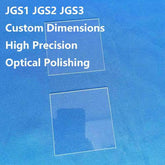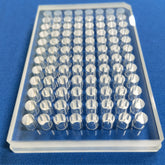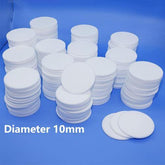The difference between quartz glass and ordinary glass
With the continuous rapid development of society, the types of glass are becoming more and more diverse, which can meet the needs of various occasions. After adjusting its materials and properties, glass materials can undergo different changes, making it more stable and durable. Let's take a look at the differences between quartz glass and regular glass together.
- Different hardness
The hardness of the former can generally reach Mohs level seven, while the hardness of the latter can generally only reach levels 5.5 to 6.
- Different light transmittance
The former can pass through infrared and ultraviolet rays, while the latter cannot.
- Different colors
The former generally has no color, while the latter generally has a certain color.
- Different high temperature resistance
 After the former is burned red, even if it is immediately placed in water, it is not easy to crack, while once the latter is burned, it will immediately crack.
After the former is burned red, even if it is immediately placed in water, it is not easy to crack, while once the latter is burned, it will immediately crack.
The difference between quartz glass and ordinary glass: quartz is crystal and glass is amorphous solid.
- The main components of ordinary glass are sodium silicate, silicon dioxide, and calcium silicate, while the main component of quartz glass is silicon dioxide.
- The content of silica varies. Quartz glass is made by melting pure silica, with a content of over 99%. The silicon dioxide content of ordinary glass is generally between 70% -75%, and other components are alkali metals or alkaline earth metals such as sodium oxide and calcium oxide, in order to reduce melting temperature and improve material properties.
- Quartz is a mineral composed of silicon dioxide, with the chemical formula SiO2. Pure quartz is colorless and transparent, and appears in various colors due to the presence of trace pigment ions, finely dispersed inclusions, or color centers, which reduces transparency. It has a glassy luster, and the fracture surface has a greasy luster. Hardness 7, no cleavage, conchoidal fracture, specific gravity 2.65, piezoelectricity.

Quartz is one of the minerals widely distributed on the earth's surface. There are many types of quartz. Vein quartz, quartz sand, quartzite, sandstone, silica, opal, diatomite, etc. are used as raw materials for daily ceramics. It is a substance homologous to ordinary sand and crystal.
Glass is an amorphous inorganic non-metallic material, which is generally made of a variety of inorganic minerals (such as quartz sand, borax, boric acid, barite, barium carbonate, limestone, feldspar, soda ash, etc.) as the main raw materials, and a small amount of auxiliary raw materials are added. Its main components are silicon dioxide and other oxides. The chemical composition of ordinary glass is Na2SiO3, CaSiO3, SiO2 or Na2O · CaO · 6SiO2, etc. The main component is silicate double salt, which is an amorphous solid with an irregular structure. Widely used in buildings for wind and light insulation, it belongs to mixtures. There are also colored glass mixed with oxides or salts of certain metals to show color, and tempered glass made through physical or chemical methods.
The simple classification of glass is mainly divided into flat glass and deep processed glass. Plate glass is mainly divided into three types: pull-up plate glass (divided into slotted and non slotted types), flat pull plate glass, and float glass. Due to its uniform thickness, flat and parallel upper and lower surfaces, as well as factors such as high labor productivity and easy management, float glass is becoming the mainstream of glass manufacturing methods.







1 comment